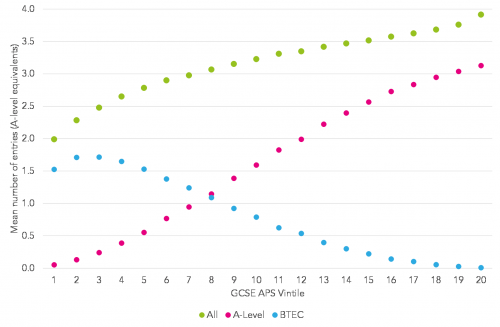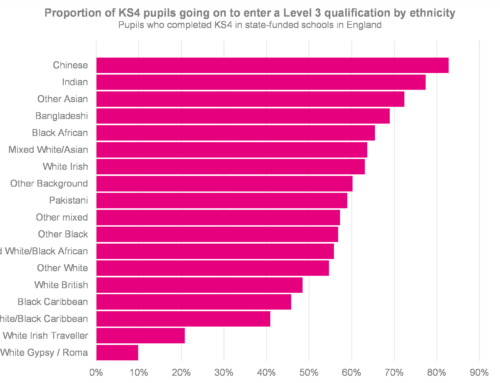New analysis
This post was published in 2017.
We’ve subsequently looked at the equivalence of A-Levels and reformed BTECs.
* Updated 3rd April 2017 following helpful feedback from UCAS*
Last week, the Higher Education Policy Institute published a report on BTECs and university admissions [PDF].
It recognised that much of the increase in the proportion of young people achieving Level 3 – A-Levels or equivalents – by age 19 (see Table 3 here, XLSX) has been driven by increased participation in BTECs and other vocational qualifications.
And colleagues at the Social Market Foundation have previously shown that there was a threefold increase in number of pupils taking a BTEC between 2006 and 2015 (see Figure 3 here, PDF).
The HEPI report advises cautious reform of BTECs, urging policymakers to protect their distinctiveness whilst recognising that “the rise in the number of students achieving the highest grades is cause for concern.”
They also observe that the fact that “some BTECs have grown far more rapidly tha[n] others may reflect the capacity of schools to offer them, rather than particular demand” – although BTECs are far more common in colleges than in schools. In 2016, 76% of BTECs included in post-16 performance tables were entered by students in colleges compared to 28% of entries in A-Levels.
Analysis of 2016 Level 3 attainment data shows that BTECs tend to be taken by students with lower levels of prior attainment.
In the chart below, we have allocated all pupils who reached the end of Level 3 study in 2016 to one of 20 equally sized bands, or vintiles, based on their mean grade in GCSEs at Key Stage 4. It then shows the mean number of entries (in A-Level equivalents) in A-Levels, BTECs and all Level 3 qualifications – which includes other qualifications such as AS-Levels, applied A-Levels and technical certificates.
Mean number of entries in different Level 3 qualifications by GCSE prior attainment
Both the Department for Education and UCAS [PDF] uses points scoring systems to align BTEC grades with A-level grades. These systems are based on information on qualification size and grading published by the regulator, Ofqual.
UCAS has just upgraded its tariff system for 2017 admissions. However, the DfE and UCAS differ in how they align BTECs and A-levels, and these differences are shown in the table below.
Whereas UCAS aligns a distinction in a BTEC to a grade A at A-Level, the DfE only consider it to be midway between grade B and grade C. However, it should be noted that the two points scoring systems serve different purposes, HE admissions and school and college accountability respectively.
| BTEC grade | UCAS tariff | UCAS equivalence to A-Level | DfE points | DfE equivalence to A-Level |
| Starred distinction | 56 | A* | 50 | A |
| Distinction | 48 | A | 35 | Between B and C |
| Merit | 32 | C | 25 | Between C and D |
| Pass | 16 | E | 15 | Between D and E |
Now that performance tables report results in A-Levels separately to applied general qualifications, the DfE system of equivalence is arguably less relevant.
But UCAS points can still be used for university admission, although as the HEPI report makes clear, this varies by institution. UCAS suggests that only around one-third of courses admit on the basis of points, the majority still doing so on the basis of grades.
Nonetheless, the equivalence of BTECs and A-Levels has to be addressed. Is a student who has achieved three distinctions in an extended BTEC Diploma of equivalent ability to a student with three As at A-Level, as a literal interpretation of the UCAS points system implies?
The next chart shows the average UCAS points per entry for BTECs and A-Levels achieved in 2016. In some parts of the KS4 distribution BTECs score the equivalent of two grades higher than A-Levels. Over 30% of BTEC awards are graded starred distinction. These are considered equivalent to A* at A-Level yet under 10% of A-Levels were graded as such.
Average UCAS points per entry by GCSE prior attainment
The picture is further complicated by the fact that there are variations in grades awarded in different subjects. We examined the severity of grading in different A-Levels here. There are also variations between BTECs. Those equivalent to a single A-Level (e.g. a subsidiary diploma) tend to score more highly. We leave this to one side.
I’ve suggested a different set of UCAS points for BTECs in the table below.
| BTEC grade | Suggested points | Suggested equivalence to A-Level |
| Starred distinction | 38 | Between B and C |
| Distinction | 32 | C |
| Merit | 24 | D |
| Pass | 16 | E |
These scores work reasonably well for vintiles 1-13 where most BTEC entries are located. But as we’ve capped the maximum BTEC score at 38, A-Level and BTEC scores begin to diverge for students with higher prior attainment.
There may be an argument for extending or reforming the grading scale used for BTEC qualifications. However, this would be a decision that ultimately Ofqual would have to take.
Average UCAS points per entry by GCSE prior attainment using suggested points
Want to stay up-to-date with the latest research from Education Datalab? Sign up to our mailing list to get notifications about new blogposts, or to receive our half-termly newsletter.








Hello
Please can anyone tell me what the equivalent to a advanced diploma level 3 / distinction was the pass
Thanks
Please advise A level equivalent of a. BTech graded DistinctionA in Business Studies
Hi James. Do you know which type of BTEC it is (e.g. National Extended Certificate, National Extended Diploma)?
National Diploma
What is the grade Distinction distinction in btec applied forensic science certificate please in qualifications
Hi Susan. Do you mean this? https://qualifications.pearson.com/content/dam/pdf/BTEC-Nationals/Forensics-and-Criminology/2017/Specification/6030246X-diploma-forensic-and-criminal-investigation-purpose.pdf If so, distinction distinction is equivalent to 2 A-levels at grades BC (70 points).
Hi what does a distinction and Merit grade in applied science in a-level qualification and ucas points ?
thank you very much
Hi. If it’s a BTEC Diploma it’s 80 points. UCAS points for all quals can be found in https://www.ucas.com/file/63536/download?token=sxmdfCS-